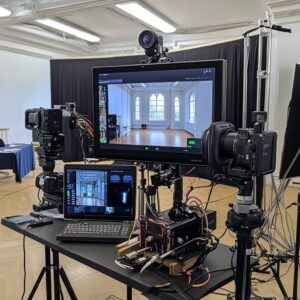5 things to consider before buying a commercial audio visual system
Installing a high-quality audio-visual system offers tremendous potential benefits for many businesses. While there are many options on the market today, they aren’t all equally suitable for your company’s needs or budget. Asking the right questions at the beginning of the process is critical to getting the best commercial audio visual system for you.
An AV integrator can design, install, configure, and maintain a wide range of audio-visual solutions. However, they need your help to make sure the system lives up to its full potential for you.
Consider these five questions to get the highest return on your investment from your new commercial audio-visual installation.

First-Things-First – What is audio visual equipment?
Before moving into the five prompting questions, it might help to specify what falls under the umbrella of ‘audio-visual equipment.’ You might have seen this written as ‘audio video’ or abbreviated as ‘AV,’ which are interchangeable terms.
AV equipment is the collection of electronic media hardware devices that record and transmit audio (sound) and video (sight) signals.
AV items are commonplace today and vital to modern communication across the globe. The type of AV gear necessary for a particular environment or event depends on many factors, so not everything on this list may apply to your situation.
- Microphones
- Lighting system
- Sound system
- Mixing board
- Video cameras
- Projectors
- Screens
- Electrical supply
- Control panel
- Smart boards
1. How will the space be used?
What functions are happening in the room? Which of those are frequent, and which of those are rare occurrences? Is it a small room for in-person meetings or hybrid gatherings? It is a large room that alternates between a gathering space for your team and a meeting room for outside constituents. Do you have an auditorium-sized space that brings in large crowds that must be able to switch between a full performance stage to a single person speaking behind a podium?
How formal or informal are those events? Is it a formal meeting room where you host clients or a place where employees gather to brainstorm new ideas? The formality of a board room versus the comfort of a teleconferencing space for internal teams might inform types of infrastructure and therefore is worth noting.
The daily function of a room will have a meaningful impact on selecting the right equipment to meet your needs.
2. Who is my primary audience?
This question focuses on who is operating the AV equipment, not necessarily everyone who is benefiting from it.
Will it be the same people using the room, or will it constantly be different people? A more complex system requires more training. People tend to forget complicated processes they don’t use regularly. A teleconferencing space used by everyone in a large company is different from a concert hall with a small, dedicated staff working with all of the equipment.
Will someone help with set-up, or does it need to be self-service? How tech-savvy are the users? The complexity of operating a system needs to get factored into the plan. People who use the space regularly are more likely to remember how to set everything up than folks who use it infrequently. Having a dedicated person set up the room removes pressure from everything needing to be plug-and-play.
More complex systems with less experienced users necessitate an easy-to-use control panel.
3. Where is the highest quality most important?
Commercial technology comes in a range of quality, and everyone wants the best for everything. Unfortunately, budgets don’t always allow everything to be top-of-the-line.
What are the most important goals with the space? Are we designing a conference room where having participants phoning in on smartphones, some in person, and others using video meeting software all need to be able to hear one another? Or is clarity from one microphone throughout an echoing room the biggest problem we are solving?
Prioritizing needs helps match the right equipment to a budget.
4. Can we use our old AV equipment?
Are we trying to reuse this piece because of how much we spent on it? Does it have unique functionality? When was the last time we used it? Can we reuse it elsewhere and phase out the older stuff?
Using existing equipment can save money, but it is only a good choice if it supports the other elements of a new system and isn’t likely to become obsolete too soon.
5. Do I need an integrated system?
An integrated audio-visual system is one where your AV equipment functions as a single unit. By coordinating microphones, speakers, projectors, displays, control panels, video conferencing software, and more into one interface, you improve the functionality of your facility. Have you ever had two pieces of technology that were supposed to complement one another but weren’t compatible? A well-designed plan avoids that problem.
Integrated systems offer many benefits. First, they often require fewer technical skills to operate since everything is in one place. They also run more efficiently and save valuable time.
Last Words on Buying a Commercial Audio Visual System
Installing a new AV system can be a daunting project. There is a lot to consider, and you want to work with a partner who will guide you to a solution that meets your needs and avoids common pitfalls.
RYGID AV is a leader in providing audio-visual solutions. We are authorized dealers for many products used commercially, which means we have a relationship with product producers and can offer the best pricing and rebates. We use our in-house team of professional installers to get your job done. If you have a commercial audio-visual installation project, especially near Davidson, NC or in Catawba County, North Carolina, we can help.



